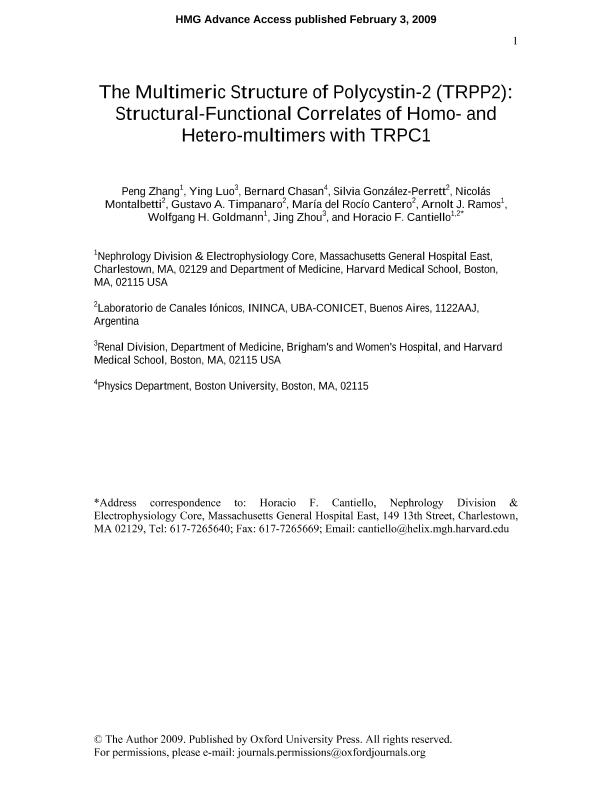Mostrar el registro sencillo del ítem
dc.contributor.author
Zhang, Peng
dc.contributor.author
Luo, Ying
dc.contributor.author
Chasan, Bernard
dc.contributor.author
González Perrett, Silvia
dc.contributor.author
Montalbetti, Nicolas

dc.contributor.author
Timpanaro, Gustavo A.
dc.contributor.author
Cantero, Maria del Rocio

dc.contributor.author
Ramos, Arnolt J.
dc.contributor.author
Goldmann, Wolfgang H.
dc.contributor.author
Zhou, Jing
dc.contributor.author
Cantiello, Horacio Fabio

dc.date.available
2020-11-10T21:07:29Z
dc.date.issued
2009-04
dc.identifier.citation
Zhang, Peng; Luo, Ying; Chasan, Bernard; González Perrett, Silvia; Montalbetti, Nicolas; et al.; The multimeric structure of polycystin-2 (TRPP2): Structural - Functional correlates of homo- and hetero-multimers with TRPC1; Oxford University Press; Human Molecular Genetics; 18; 7; 4-2009; 1238-1251
dc.identifier.issn
0964-6906
dc.identifier.uri
http://hdl.handle.net/11336/118106
dc.description.abstract
Polycystin-2 (PC2, TRPP2), the gene product of PKD2, whose mutations cause autosomal dominant polycystic kidney disease (ADPKD), belongs to the superfamily of TRP channels. PC2 is a non-selective cation channel, with multiple subconductance states. In this report, we explored structural and functional properties of PC2 and whether the conductance substates represent monomeric contributions to the channel complex. A kinetic analysis of spontaneous channel currents of PC2 showed that four intrinsic, non-stochastic subconductance states, which followed a staircase behavior, were both pH- and voltage-dependent. To confirm the oligomeric contributions to PC2 channel function, heteromeric PC2/TRPC1 channel complexes were also functionally assessed by single channel current analysis. Low pH inhibited the PC2 currents in PC2 homomeric complexes, but failed to affect PC2 currents in PC2/TRPC1 heteromeric complexes. Amiloride, in contrast, abolished PC2 currents in both the homomeric PC2 complexes and the heteromeric PC2/TRPC1 complexes, thus PC2/TRPC1 complexes have distinct functional properties from the homomeric complexes. The topological features of the homomeric PC2-, TRPC1- and heteromeric PC2/TRPC1 channel complexes, assessed by atomic force microscopy, were consistent with structural tetramers. TRPC1 homomeric channels had different average diameter and protruding height when compared with the PC2 homomers. The contribution of individual monomers to the PC2/TRPC1 hetero-complexes was easily distinguishable. The data support tetrameric models of both the PC2 and TRPC1 channels, where the overall conductance of a particular channel will depend on the contribution of the various functional monomers in the complex.
dc.format
application/pdf
dc.language.iso
eng
dc.publisher
Oxford University Press

dc.rights
info:eu-repo/semantics/openAccess
dc.rights.uri
https://creativecommons.org/licenses/by-nc-sa/2.5/ar/
dc.subject
PC2
dc.subject
Amiloride
dc.subject
Cations
dc.subject
Genes
dc.subject.classification
Biofísica

dc.subject.classification
Ciencias Biológicas

dc.subject.classification
CIENCIAS NATURALES Y EXACTAS

dc.title
The multimeric structure of polycystin-2 (TRPP2): Structural - Functional correlates of homo- and hetero-multimers with TRPC1
dc.type
info:eu-repo/semantics/article
dc.type
info:ar-repo/semantics/artículo
dc.type
info:eu-repo/semantics/publishedVersion
dc.date.updated
2020-09-08T14:05:45Z
dc.journal.volume
18
dc.journal.number
7
dc.journal.pagination
1238-1251
dc.journal.pais
Reino Unido

dc.journal.ciudad
Oxford
dc.description.fil
Fil: Zhang, Peng. Harvard Medical School; Estados Unidos. Massachusetts General Hospital; Estados Unidos
dc.description.fil
Fil: Luo, Ying. Brigham And Women's Hospital; Estados Unidos
dc.description.fil
Fil: Chasan, Bernard. Boston University; Estados Unidos
dc.description.fil
Fil: González Perrett, Silvia. Consejo Nacional de Investigaciones Científicas y Técnicas. Oficina de Coordinación Administrativa Houssay. Instituto de Investigaciones Cardiológicas. Universidad de Buenos Aires. Facultad de Medicina. Instituto de Investigaciones Cardiológicas; Argentina
dc.description.fil
Fil: Montalbetti, Nicolas. Consejo Nacional de Investigaciones Científicas y Técnicas. Oficina de Coordinación Administrativa Houssay. Instituto de Investigaciones Cardiológicas. Universidad de Buenos Aires. Facultad de Medicina. Instituto de Investigaciones Cardiológicas; Argentina
dc.description.fil
Fil: Timpanaro, Gustavo A.. Consejo Nacional de Investigaciones Científicas y Técnicas. Oficina de Coordinación Administrativa Houssay. Instituto de Investigaciones Cardiológicas. Universidad de Buenos Aires. Facultad de Medicina. Instituto de Investigaciones Cardiológicas; Argentina
dc.description.fil
Fil: Cantero, Maria del Rocio. Consejo Nacional de Investigaciones Científicas y Técnicas. Oficina de Coordinación Administrativa Houssay. Instituto de Investigaciones Cardiológicas. Universidad de Buenos Aires. Facultad de Medicina. Instituto de Investigaciones Cardiológicas; Argentina
dc.description.fil
Fil: Ramos, Arnolt J.. Harvard Medical School; Estados Unidos. Massachusetts General Hospital; Estados Unidos
dc.description.fil
Fil: Goldmann, Wolfgang H.. Harvard Medical School; Estados Unidos. Universitat Erlangen-Nuremberg; Alemania. Massachusetts General Hospital; Estados Unidos
dc.description.fil
Fil: Zhou, Jing. Brigham And Women's Hospital; Estados Unidos
dc.description.fil
Fil: Cantiello, Horacio Fabio. Massachusetts General Hospital; Estados Unidos. Consejo Nacional de Investigaciones Científicas y Técnicas; Argentina. Harvard Medical School; Estados Unidos
dc.journal.title
Human Molecular Genetics

dc.relation.alternativeid
info:eu-repo/semantics/altIdentifier/url/https://academic.oup.com/hmg/article/18/7/1238/673790
dc.relation.alternativeid
info:eu-repo/semantics/altIdentifier/url/https://www.ncbi.nlm.nih.gov/pmc/articles/PMC2722194/
dc.relation.alternativeid
info:eu-repo/semantics/altIdentifier/doi/https://doi.org/10.1093/hmg/ddp024
Archivos asociados
